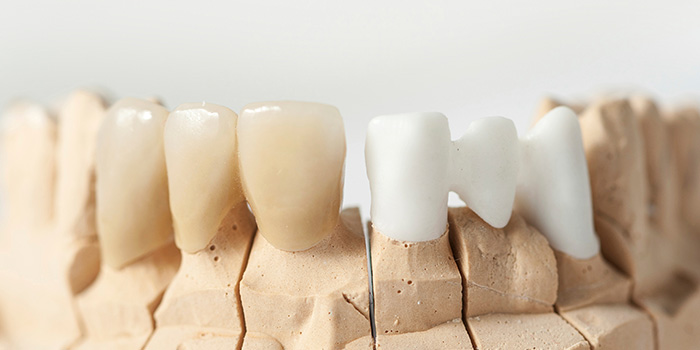

Crowns and Bridges
Bridge (Fixed Prosthetics)
A bridge is a restoration that replaces one or more teeth that have been lost. This restoration is permanently cemented.
Reasons to have a bridge: The loss of a tooth may cause your mouth to sink and your face to look older. A bridge helps maintain the natural shape of your face and prevents the movement of teeth that would otherwise occur and negatively affect the way you chew and speak. A fixed bridge is commonly cemented to the natural teeth next to the space left by the missing teeth. A false tooth replaces the lost tooth, and crowns on either side of the bridge provide support.

Taking care of your bridge: It is very important to keep your remaining teeth healthy. A bridge can lose its support if the supporting and surrounding teeth or the jawbone that holds it becomes damaged by dental diseases. Brushing twice a day with fluoride toothpaste and cleaning between the teeth and under the bridge with floss or other interdental cleaners, is essential to maintain the bridge foundation.
Crowns
A crown is a restoration that covers, or caps, a tooth to restore it to its normal shape and size. Its purpose is to strengthen and improve the appearance of a tooth. A crown is placed for a number of reasons:
- to support a large filling when there isn’t enough tooth remaining
- to attach a bridge
- to protect a weak tooth from fracturing
- to protect a tooth with a root canal treatment from fracturing
- to restore a fractured tooth
- to cover a badly shaped or discolored tooth
- to cover a dental implant
Usually, two visits are necessary to place a crown. At the first visit the tooth must be prepared and an impression made to provide a model for the dental lab that makes the crown. In addition, a temporary crown is placed on the tooth. At the second visit, the permanent crown is cemented in.
What is a temporary crown? Temporary crowns are made of hard plastic or metal (stainless steel) and protect the prepared tooth and allow you to eat and speak normally while you wait for the permanent crown.

Materials: Crowns are made from a number of materials. Gold alloys or nonprecious alloys, porcelain or ceramic, acrylic or composite resin, or combinations of these materials. Materials vary in cost, durability, and appearance. We will discuss with you which are best suited for your new crown based on your own unique dental circumstances.
Our services include:
- full porcelain
- porcelain covered gold alloy

